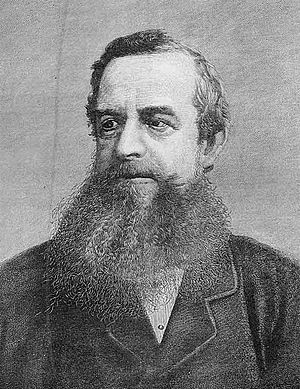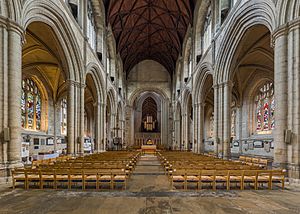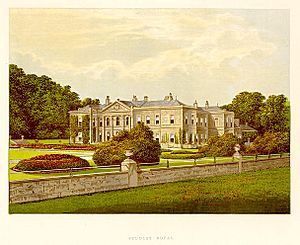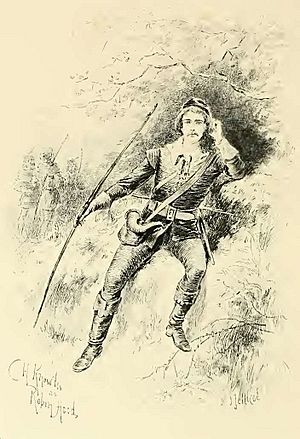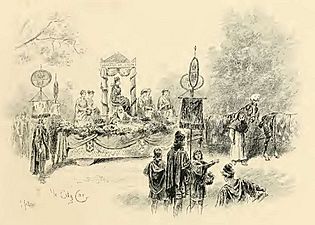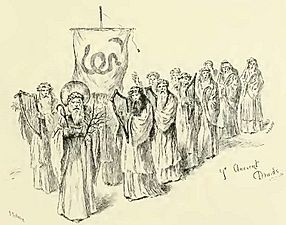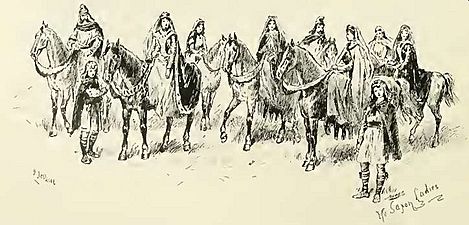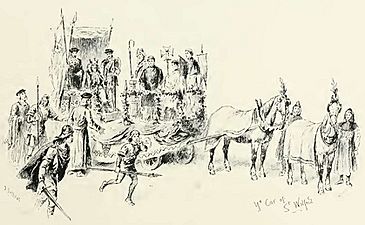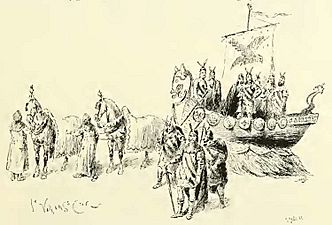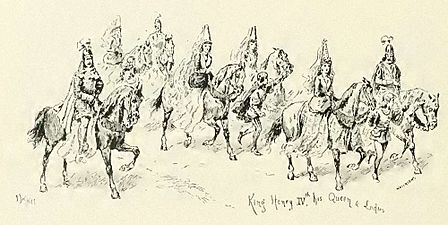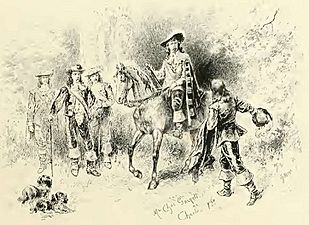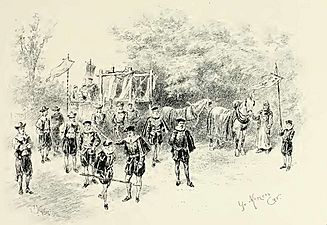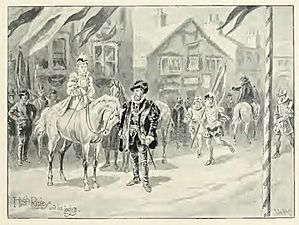Ripon Millenary Festival facts for kids
The Ripon Millenary Festival was a huge celebration held in Ripon, England, in August 1886. It lasted about a week, but the main fun happened over two days. People celebrated what they thought was the 1,000th birthday of Ripon getting a special permission (a "royal charter") from Alfred the Great, a famous king.
| Date | 25 August – 1 September 1886 |
|---|---|
| Duration | Five days from Wednesday to Sunday |
| Venue | Mainly at Studley Royal Park and Fountains Abbey |
| Location | Ripon, North Yorkshire, England |
| Type | Merrie England Pagaent |
| Theme | The History of Ripon |
| Budget | £1,776 1s 11d |
| Patrons | Lord and Lady Ripon |
| Organised by | Ernest Richard D'Arcy Ferris (2 April 1855 – 4 July 1929) |
| Participants | The people of Ripon |
| Outcome | A Brilliant Success |
| The festival celebrated the anniversary of the supposed granting of a royal charter by Alfred the Great to Ripon in 886. | |
Contents
- Why Ripon Celebrated This Festival
- Planning the Big Event
- The Festival Programme: What Happened?
- The Festival's Big Success
- Other Big Pageants
Why Ripon Celebrated This Festival
In the late 1800s, many people became very interested in the Middle Ages. They wanted to bring back old traditions and fun events that had been lost over time.
A man named D'Arcy Ferris, who became the festival's main organizer, loved these old traditions. He wanted to bring back things like Morris dancing and other medieval games. He believed that these fun activities could make life better for everyone, especially for poorer people. He also hoped it might help different social classes get along better.
Planning the Big Event
The idea for the festival started in January 1886. A local church leader wondered what Ripon would do to celebrate its 1,000-year anniversary. Soon, important people in the town asked the Mayor to hold a meeting. They wanted to plan a big celebration.
By March, a general plan was ready. Even though some town officials were unsure, a public meeting was held in April. The festival committee then decided on the name for the event. They also met with Lord Ripon, a very important local figure. Lord Ripon agreed to let them use his beautiful grounds. He and Lady Ripon also became supporters of the festival.
In May, D'Arcy Ferris joined the committee. He shared his detailed plans for how the festival would work. He was hired as the "Master of the Revels" (the main organizer of the fun) for a fee. He worked very hard, and the planning moved super fast!
The Festival Programme: What Happened?
Wednesday, August 25: The Grand Opening
The festival kicked off early on Wednesday, August 25, 1886. At 5 AM, bell-ringers climbed the Ripon Cathedral tower. They rang the bells for over three hours!
Later that morning, important guests arrived. A formal parade marched from the town hall to the cathedral. This parade included town leaders, two bands, and even mayors from 14 other towns. Each mayor had their special staff (a "mace bearer") with them.
The cathedral was packed an hour before the service began. The music showed how church music had changed over hundreds of years. The Archbishop of York gave a sermon. After the service, over a thousand guests enjoyed a big lunch. Then, everyone went to the Market Square for speeches. The dean of the cathedral gave a special horn to the town. The day ended with a torchlit parade. It had bands, decorated floats, and people dressed in old-fashioned costumes.
Thursday, August 26: Market Day
Thursday was Ripon's usual market day. The town was still decorated, but there were no big festival events. This was because the people playing roles in the festival had to go back to their regular jobs. "Business must be attended to!"
However, many people went to the cathedral. They celebrated the bishopric's 50th anniversary. A new stained-glass window was also shown for the first time.
Friday, August 27: The Pageant at Studley Royal
Visitors poured into Ripon from all over the area. The mayor had declared a public holiday. All businesses closed, and everyone headed to the Studley Estate. Lord Ripon had kindly allowed the festival to use his land. This estate includes the beautiful ruins of Fountains Abbey, a very old monastery. Today, both are owned by the National Trust and are a World Heritage site.
People arrived all morning by train, cart, and coach. The pageant participants gathered near Lord Ripon's home. Then, they paraded through the grounds to Fountains Abbey. There, two choirs, dressed as old monks, sang special music. About 5,000 to 6,000 people watched the pageant on Friday!
A play called Robin Hood and ye Curtall Friar was performed. It was chosen because it was perfect for an outdoor show. It had little talking but lots of singing! The play was based on an old story about Robin Hood meeting a monk near Fountains Abbey. The hour-long play was performed right where the story was supposed to have happened.
The audience sat around an open area, watching the players. Then, "knightly" sports began. This included tilting, where riders tried to hit a target with a lance. There was also a spinning target called a quintain. If you weren't careful, it would hit you! One person was even knocked off their horse. After that, there was sword dancing and ribbon dancing. Finally, the jousting began! But these "knights" rode hobby-horses, not real ones. Rain stopped the sports, and the crowd returned to Ripon. In the evening, there was entertainment at the new public hall.
Who Was in the Pageant Parade?
The parade was huge and colorful! Everyone wore amazing costumes, either made at home or rented. Here are some of the groups:
- Wild men carrying clubs.
- Twenty Druids (ancient priests) with harps.
- A Roman Chariot with nine Romans.
- A float shaped like a Viking ship with eight Vikings.
- Saxon rulers and clergy, many on horseback.
- A float with St Wilfrid and his followers.
- A float with King Alfred and his helpers.
- King Athelstan on horseback.
- King Henry IV on horseback with his wife and court.
- A beautiful arch symbolizing peace, with maidens and youths.
- A float with the Queen of the Harvest and young women.
- The first two Members of Parliament for Ripon on horseback.
- Characters from the Robin Hood story.
- The band of the 1st West Yorkshire Volunteers.
- Nearly forty foresters who sang in the play.
- Hugh Ripley, the last "Wakeman" of Ripon, on horseback with his lady.
- People carrying banners from different villages.
- Floats showing different jobs, like spur-makers, saddle-tree makers, brewers, and millers.
- King Charles I on horseback with his cavaliers.
- People carrying banners of different medieval guilds (groups of workers):
* Butchers * Curriers (who prepare leather) * Tanners (who make leather) * Mercers (who sell fancy fabrics) * Farriers (who shoe horses) * Tailors (who make clothes) * Innholders (who run inns) * Ropemakers * Glovers (who make gloves) * Cordwainers (who make shoes) * Barbers (who cut hair, and used to do surgery!) * Chemists (who deal with medicines) * Dyers (who color cloth) * Drapers (who sell cloth)
- The band of the 9th Queen's Royal Lancers.
- A group of priestesses.
- Boys carrying banners.
- A float with the Lady Mayoress, representing the seven virtues, and boys representing the Rivers Ure and Skell.
- Young women as maypole dancers.
- A float with young women representing the three graces and four seasons.
- Girls in Georgian costumes scattering flower petals.
- Boys and girls dressed as Georgian maypole dancers.
- The Maypole Queen and her helpers.
- Sword dancers with musicians and a clown.
- A Georgian farmer and his wife.
- A Georgian shepherd and shepherdess with a dog and lambs.
- The band of the 1st North Yorkshire Volunteers.
- Ripon City officials and mayors from other towns in their full robes.
About 500 people took part in the pageant itself. This was almost 5% of Ripon's population at the time! Many others helped behind the scenes, like caterers and railway workers.
Illustrations of the pageant procession by John Jellicoe
Saturday, August 28: More Fun and Games
On Saturday, the entrance fee was cheaper, which meant even more people came! About 8,000 arrived by train, and another 10,000 to 12,000 came by other ways. The market place was full of fun things to do, like shooting galleries, carousels, and swing-boats.
The pageant gathered at Studley again. At 1:30 PM, they paraded to Fountains Abbey. The play was performed again, and Friday's entertainments were repeated. This time, they even added a pretend bull-baiting game, with boys acting as dogs! The parade then returned to Ripon. At 7:30 PM, they marched to the town hall. There were a few speeches, and the festival was officially closed.
Tuesday, August 31: A Costume Party
There were no festival activities on Sunday or Monday. But on Tuesday, there was a special party at the New Public Hall. It was for everyone who had been in the parade or helped with the festival. The only rule was that they had to come in costume! The colorful sight drew a huge crowd. After the reception, everyone enjoyed a country dance.
Wednesday, September 1: The Final Feast
The very last event of the festival was a venison (deer meat) supper. It was held for the "Foresters" group at the White Horse Hotel. The venison came from a deer that Lord Ripon had given them. This supper officially ended all the celebrations for Ripon's 1,000-year anniversary.
The Festival's Big Success
The Ripon Millenary Festival was a huge hit! The play, the fun activities, and the parade were all incredibly successful. In fact, they were so popular that they were repeated ten and twenty years later, still led by D'Arcy Ferris.
The success of this festival made D'Arcy Ferris famous. He became known as the best "Master of Revels" and "Pageant Master" of his time in England.
Other Big Pageants
The Ripon Festival was a large pageant for its time. But in the years that followed, even bigger and more complex pageants were held as the idea grew.
For example, the York Historic Pageant in 1909 was much larger. It lasted six days and told the history of York in seven parts. It made so much money that the organizers were able to pay back everyone who had helped fund it. About 30,000 people watched the York pageant, and 2,500 people performed in it! This shows how much pageants had grown since the Ripon Festival.


